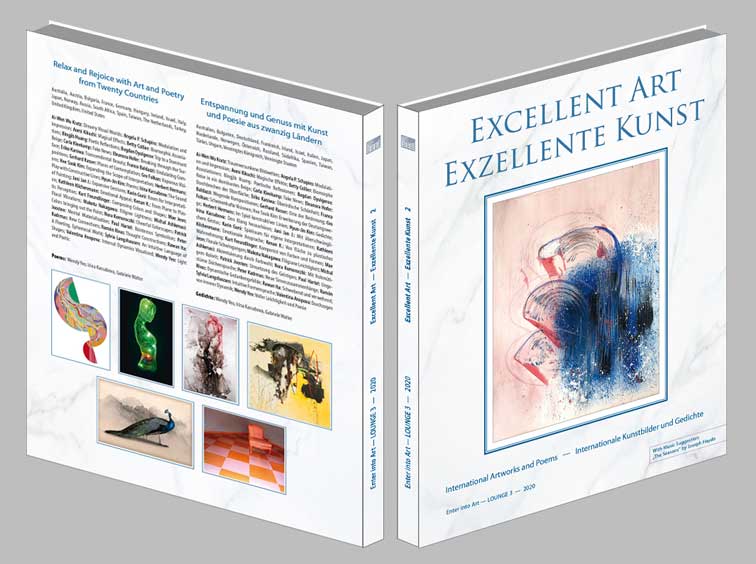Excerpt from the book “Excellent Art 2020”
Starting in Volume 2 of the “Excellent Art” series, each book will introduce one famous musical work that may contribute to the harmonious overall sound, alongside the topic related selection of haiku poetry. By introducing a musical work, the editor hopes to inspire readers to expand their perception to the tonal aspects of art and poetry. Inspired by the composer’s international experiences, and the way he uses notes like a painter in this work, she has chosen “The Seasons” by Joseph Haydn. After all, the seasons are of universal importance in the poetry of the world’s peoples.
Music Suggestion
‘The Seasons’ by Joseph Haydn
One of the most popular musical creations of the Viennese School is the oratorio “The Seasons” by Joseph Haydn. With his last major work, Haydn made a significant contribution to the development of program music. Surrounded by a beautiful orchard, he wrote it in his Gumpendorf home near Vienna after moving into the newly refurbished house in 1797. On two triumphant trips to England, he had celebrated his greatest successes, which finally earned him a well-deserved fortune.

The text and the poems in this post are excerpts from the book “Excellent Art – Exzellente Kunst 2020″.
Influenced by Rousseau’s philosophy, “The Seasons” is based on depictions of nature and a romanticized view of country life. It is known as a moral tale conveying a free-thinking world view, and the laudable approach of the European Enlightenment, which had culminated in the discovery that, in a meaningful world, man was obliged to act according to Humanist ethics. The libretto written by Baron Gottfried van Swieten, was an abridged German rendering of the famous epic poem “The Seasons” by James Thomson. Although the German version was not received well, Haydn’s music conquered audiences’ hearts. Written for a large late-classical orchestra and a chorus singing mostly in four parts, “The Seasons” are arguably more beautiful than the more famous “Creation”. In the context of their time, they were a highly avant-garde work.
The three vocal soloists Simon, the old peasant (bass), his daughter Hanne (soprano), and Lucas, the young peasant (tenor), represent archetypal country folk. In arias, trios, and recitatives, they articulate the emotions nature evokes in them. The two-and-a-half-hour oratorio consists of four parts: Spring, Summer, Fall, and Winter. The musical journey through the seasons ends with the metaphor of a dying winter landscape. It is palpable how this parable of nature made the aging composer painfully aware of life’s transient nature.
Joseph Haydn was a generous supporter of young composers like Mozart and Beethoven. Beethoven, for example, was inspired by “The Seasons” to write his “Pastoral Symphony” after following his invitation to Vienna. Known among his contemporaries for his pleasant, optimistic personality, Haydn cultivated a warm working environment. An aria in the oratorio written from the perspective of a dog bears witness to his famous sense of humor. As an art lover, he collected numerous copperplate engravings, 140 of them during his time in London, mostly contemporary works.
According to Goethe, “The Seasons” are marked by an idiosyncratic type of “musical painting”. The work is often described as visually oriented. A hunting song is illustrated with the sound of French horns, a raging storm comes alive as the voices of the chorus are unleashed in dramatic gusts, a prayer for a good harvest is sung, a wine festival celebrated by dancing peasants, and fittingly concluded by the “tipsy fugue”, as Haydn himself called it. The oppressive midday heat is made palpable with flickering sounds, a bird virtually succumbs to a bang on the timpani. Winter starts with a thick mist spreading throughout the c-minor adagio. Disoriented by it, the wanderer gets lost. In the end, warm sounds in E-major welcome him to a chalet.
But the whole world understands my language.
Joseph Haydn (1732 – 1809)
Art Meditation
Imagine you are at an exhibition featuring the works in the book, mindfully observing them. Close your eyes and observe your breath, or listen to it, until you feel pleasantly calm. Pick a painting:
- What is this artwork about? What is special about it?
- Take your time and analyze the colors and shapes in this work. Feel their sound!
- What spontaneous associations does this artwork trigger in you?
- What would you say is “that certain something” about it – that mysterious aspect that is difficult put into words, and that has sprung directly from the artist’s soul?
Haiku Poetry
All of a sudden
The cuckoo‘s call among the
White, juicy petals.
Wine-red velvet rose
Standing alone by the well
With its sweet fragrance.
On a fragrant note
Of saffron the larches
Celebrate their requiem.
On a clear, blue day
In winter, the moon’s face shows
Up in the puddles.
Sources: Please see the authors, poet and bibliography in the above link to the online book (imprint at the end of the book)!
